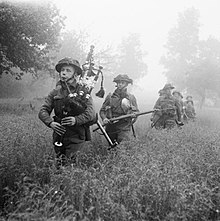
Back Binioù skos Breton Skotské dudy Czech Great Highland Bagpipe German Šoti torupill Estonian Eskoziar Lur Garaietako xirolarrua Basque Great Highland bagpipe French A' Phìob Mhòr Scots/Gaelic Gaita escocesa Galician Cornamusa scozzese Italian グレート・ハイランド・バグパイプ Japanese



The great Highland bagpipe (Scottish Gaelic: a' phìob mhòr pronounced [a ˈfiəp ˈvoːɾ] lit. 'the great pipe') is a type of bagpipe native to Scotland, and the Scottish analogue to the great Irish warpipes. It has acquired widespread recognition through its usage in the British military and in pipe bands throughout the world.
The bagpipe of any kind is first attested in Scotland around 1400.[1] The earliest references to bagpipes in Scotland are in a military context, and it is in that context that the great Highland bagpipe became established in the British military and achieved the widespread prominence it enjoys today, whereas other bagpipe traditions throughout Europe, ranging from Portugal to Russia, almost universally went into decline by the late 19th and early 20th century.
Though widely famous for its role in military and civilian pipe bands, the great Highland bagpipe is also used for a solo virtuosic style called pìobaireachd, ceòl mòr, or simply pibroch. Through development over the centuries, the great Highland bagpipes probably reached something like their distinctive modern form in the 18th century.
- ^ Collinson, 135